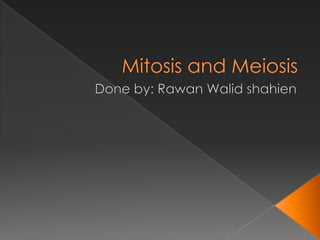
Mitosis and meiosis
- 1. Mitosis and Meiosis Done by: RawanWalidshahien
- 2. Mitosis
- 3. Interphase Interphase: Nuclear envelope still there And its before S phase because the centriolesarent duplicated yet
- 4. Prophase The chromatin condensed together to create visible chromosomes.
- 5. Prophase The spindle fibers also begin to form Migration of the two pairs of the centrioles to the opposite sides of the cell. Thinning and gradual disappearance of nuclear envelope.
- 6. Prophase Gradual mixing of the nucleolus with the rest of the nucleus. The nuclear envelope is almost completely disappeared
- 7. Metaphase Metaphase is marked by the alignment of all the chromosomes at the equatorial plane of the cell (the metaphase plate). The nuclear membrane dissolves completely, marking the beginning of metaphase. Attachment of the the spindle fibers to the centromere of the chromosome at a point called kinetochore.
- 8. Anaphase Movements of the chromosomes occurs due to shortening of spindle microtubules and kinetochore movement along the spindle fibers.
- 9. Anaphase Migration and arrival of the new chromosomes to the opposite poles of the cell.
- 10. Telophase During this stage, daughter chromosomes arrive at opposite poles of cell and the spindle fibers disappear. The chromosomes change into chromatin and become invisible under the light microscope. Nuclear envelope begins to form around the new nuclei.
- 11. Cytokinesis that takes place during telophase Cytokinesis or cleavage of the cytoplasm of the cell begins.
- 12. The result myosin molecular motors attach to the actinand draw the membrane in -like a purse string. Once the sister chromatids are separated, a ring of actin filaments (microfilaments) form a “contractile ring” around the middle of the cell By the end of telophase, two independent daughter cells have been formed
- 13. Meiosis
- 14. Interphase Interphase: “ before S phase” the nuclear envelope still there the chromosomes aren't condensed yet Replication of centrioles didn’t occur
- 15. Interphase Interphase: “ after S phase” the nuclear envelope still there the chromosomes started to condense Replication of centriolestook place
- 16. Prophase 1 Early prophase 1: The chromatin condensed together to create visible chromosomes. The spindle fibers also begin to form at this time. And centrioles begun to move away from each other The maternal and paternal homologous chromosomes come close to each other and then align Disappearance of the nuclear envelope is happening gradually
- 17. Prophase 1 Prophase 1: Same as the previous slide except that The two homologous chromosome now consists of four chromatids, so these chromosomes are called TETRAD. And now they are connected at the chiasma
- 18. Prophase 1 Late prophase 1: Crossing over takes place between the tetrad at the Chiasma *crossing over of segments of chromatids*
- 19. Metaphase 1 Metaphase1: The homologous paired chromosomes are shown to be connected by a terminal chiasma and arranged in the equatorial plate. The mitotic spindle fibers connect the centromere of each chromosome on one side and the pole of the dividing cell on the other side Attachment of the the spindle fibers to the centromere of the chromosome at a point called kinetochore. Nuclear envelope is disappearing
- 20. Anaphase 1 The terminal chiasma disappears and the chromosomes become free from each other. The centromere remains undivided so sister chromatids move together to the opposite poles of the cell. This movement occurs due to shortening of spindle microtubules and kinetochore movement along the spindle fibers. Migration and arrival of the new chromosomes to the opposite poles of the cell. Imp: here seperation of the chiasma takes place but NO division of centromere so the sister chromatids don’t separate here
- 21. Telophase During this stage, cytokinesisoccurres by contraction of actin filaments around the center of the cell which gives two daughter cells. The chromosomes become thinner and then changed to chromatin. The nuclear envelope reforms and the nucleolus reappears
- 22. Interkinesis The two daughter cells that resulted from the 1st meiotic division have 23 (1n) chromosomes and (2C) DNA. These cells pass in a short interphase called interkinesis during which duplication of centrioles occurs but no replication to DNA takes place (NO S Phase). Check in the next slide we have two yellow structure which is the centrioles so before we start meiosis 2 centrioles must be duplicated
- 23. Meiosis 2 no further replication occurs chromosomes line up again (metaphase II) sister chromatids separate (telophase II and anaphase II) the cells divide and chromosomes decondense (cytokinesis, telophase II)
- 24. The result Four haploid cells * gamete cells* in which 2 are parental , and 2 are recombinant due to crossing over
- 25. The end =D Wish you the best of luck and inshallah we will all do good in the exams and pass and get HIGH grades =) You are the best future dentists <3
